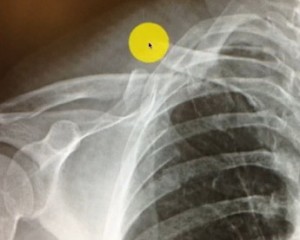The clavicle is commonly known as the collarbone. It joins the shoulder blade to the upper section of the breastbone. A clavicle fracture is a common injury, especially in young adults and children. It can occur due to sports injuries, falls, and trauma via vehicular accidents. On occasions, infants may suffer from a clavicle fracture during delivery.
Clavicle fracture is a serious condition requiring urgent medical care. Most instances of clavicle fractures are treated over time with pain medications, icing, use of slings, and physical therapy. A complex clavicle fracture may however need surgical intervention to implant screws, plates, or rods into the bone to realign the bones and maintain its correct structure during the process of healing.
Symptoms
Some of the signs and symptoms of clavicle fracture are listed below:
- Swelling
- Developing of bruises
- Tenderness
- Pain which may aggravate during shoulder movements
- Appearance of a protrusion or a bulge near or on the shoulder
- Lowered ability to move the shoulder; stiffness of the shoulder
- A cracking or grinding sound when the shoulder is moved
People who see any of the above listed symptoms of clavicle fracture, or suffer from any kind of shoulder pain that prevents normal use of the shoulder, should immediately seek medical attention. Parents should also immediately take their child to a doctor if they see the symptoms in him/her. It is vital to go for immediate diagnosis and therapy as delayed treatment can result in poor healing of clavicle fracture.
Clavicle fracture generally heals without causing any complications. Some rare complications are:
- In severe cases of clavicle fracture, the healing may be poor or it may take a lot of time. Incomplete healing can cause the bone to be shorter than before the fracture.
- The sharp edges of a broken clavicle bone can injure the adjacent blood vessels and nerves. Immediate medical attention is necessary in case of coldness or numbness in the hand or arm.
- The area where the broken clavicle bones join together during the healing process may develop a lump. Being close to the skin, such a lump is easily visible. It may fade away with time, or it may become a permanent feature.
- If the clavicle fracture involves fracture of the joints which connect the clavicle to the breastbone or the shoulder blade, then patients may develop arthritis of that joint, later in life.
- Any part of the bone which breaks the skin is at increased risk to contact with infection causing herms. In such cases, urgent treatment of the clavicle fracture is vital.
Causes
A clavicle fracture may commonly occur due to the below listed causes:
- Due to falls: Falling on an outstretched hand or directly on the shoulder can result in clavicle fracture.
- Motor accident trauma: Being involved in a motorcycle, car, or bike accident can also cause clavicle fracture.
- Sports trauma and injuries: Any kind of injury in the shoulder area due to a direct blow to it when participating in different kinds of contact sports such as football, ice hockey, etc. can result in clavicle fracture.
- Injury during childbirth: Newborns may suffer from clavicle fracture at the time of delivery.
It may be noted that the clavicle does not completely harden till one reaches the age of 20 years. Hence, teens and children are more prone to suffering from clavicle fracture. There is a decrease in the risk after the age of 20 years, but it increases once again as people grow older and the bones become weaker.
Treatment and Surgery
Clavicle fracture treatment involves the following:
- A clavicle fracture which occurs during delivery does not require any specific therapy; it usually heals on its own. Parents need to carefully handle the baby and ensure that there is no aggravation of pain.
- Medicines: Doctors may prescribe OTC pain killers to alleviate mild pain and inflammation. They may suggest prescription pain relievers for a few days to ease severe pain.
- Swelling and pain can also be alleviated via application of ice on the affected area for the initial 3 to 4 days after a clavicle fracture.
- Immobilization: Any kind of bone fracture requires restriction of movement for effective healing. Doctors may suggest the use of an arm sling to immobilize the broken clavicle. The duration of time for which the clavicle remains immobilized is dependent on the severity of the fracture. In children, bone union may occur in 3 to 6 weeks, while it may take 6 to 12 weeks in adult patients.
- Surgery: A clavicle fracture marked by severe displacement of the bone; or if it has torn the skin and come out; or if it has broken into many pieces, may need surgical treatment. Surgery for clavicle fracture typically involves placing of screws, plates, rods, or other fixation devices so as to ensure that the bones stay in the correct place when healing. Surgery does not usually cause any health complications. However, some patients may exhibit poor or deficient healing of the bone and/or infection.
- Therapy: Physical therapy and rehabilitation exercises commence after the early treatments. It helps restore joint flexibility and mobility as well as muscle strength.
